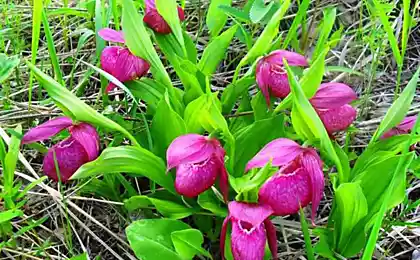232
Why do orchid roots grow up
An orchid is a plant that grows in nature in tropical latitudes, and therefore requires special care due to its special structure.
Having air roots for an orchid is normal. In natural habitats, it can live without land at all, and receives nutrients from the air and bark of trees.
The first function of orchid roots is to provide the plant with the substances necessary for full growth. The second is fixation in a substrate or on a tree.
The roots of orchids are green. Even those in the substrate are greenish. They are filled with chlorophyll and require sunlight to activate it. Therefore, the orchid is recommended to be planted in a transparent large pot.

DepositPhotos
Darkened roots of brown, ash, gray color indicate the disease of the plant. If the plant has such roots partially present, it is better to prune them so that the disease does not spread.

DepositPhotos
The roots that grow above the substrate usually do not darken. They're called airborne. You can't cut them off if they're alive. To check their condition, place the orchid under running water. Living air roots will become brighter, firmer and smoother to the touch.

DepositPhotos
Outdated roots will not change, so they need to be pruned. Otherwise, they will cause withering of the plant, will prevent the formation of a new root system.
It is strictly forbidden to prune the air roots of an orchid if it blooms. The plant may experience stress and stop flowering.
There are cases when the roots are knocked out in excessive numbers, then this is not a good sign. There are several reasons.

DepositPhotos Causes of Root Damage

DepositPhotos
How to trim damaged areas of roots
After pruning, plant the orchid in a new substrate. About how to do it correctly, read in our article. Follow the links.
Having air roots for an orchid is normal. In natural habitats, it can live without land at all, and receives nutrients from the air and bark of trees.
The first function of orchid roots is to provide the plant with the substances necessary for full growth. The second is fixation in a substrate or on a tree.
The roots of orchids are green. Even those in the substrate are greenish. They are filled with chlorophyll and require sunlight to activate it. Therefore, the orchid is recommended to be planted in a transparent large pot.

DepositPhotos
Darkened roots of brown, ash, gray color indicate the disease of the plant. If the plant has such roots partially present, it is better to prune them so that the disease does not spread.

DepositPhotos
The roots that grow above the substrate usually do not darken. They're called airborne. You can't cut them off if they're alive. To check their condition, place the orchid under running water. Living air roots will become brighter, firmer and smoother to the touch.

DepositPhotos
Outdated roots will not change, so they need to be pruned. Otherwise, they will cause withering of the plant, will prevent the formation of a new root system.
It is strictly forbidden to prune the air roots of an orchid if it blooms. The plant may experience stress and stop flowering.
There are cases when the roots are knocked out in excessive numbers, then this is not a good sign. There are several reasons.

DepositPhotos Causes of Root Damage
- Drying. When an orchid is too rarely watered, it uses air roots for self-preservation. Released outside, they have the ability to receive water from the air.
- Moldiness. Capricious orchids do not like both dryness of the environment and excess moisture. Under natural conditions, they themselves regulate how much moisture to take from tropical air. But in our region, they grow like vases in a substrate. If the roots are filled with water, they begin to mold. With excess moisture in the pot, with a lack of light and low air temperature, the roots crawl out.
- Stiffness. If orchids have many air roots And they have a dense stiffened structure, which means that the internal roots have long since stiffened, the plant has aged.

DepositPhotos
How to trim damaged areas of roots
- Prepare tools: a sharp knife or garden secator. Treat the instrument with alcohol to avoid infection.

DepositPhotos - Carefully remove the plant from the pot. Shake it off the substrate. Examine the entire root system. Cut off damaged or obsolete areas. Need to. prune and internal. Cut, grab a centimeter of the healthy part of the root.

DepositPhotos - Places cuts treated with a solution of permanganate, fungicide or crushed wood or activated charcoal. If desired, you can also soak the roots in a vitamin solution for 15 minutes to nourish them. To do this, mix 1 ampoule of vitamin B, B1 and B12.

DepositPhotos
After pruning, plant the orchid in a new substrate. About how to do it correctly, read in our article. Follow the links.
























